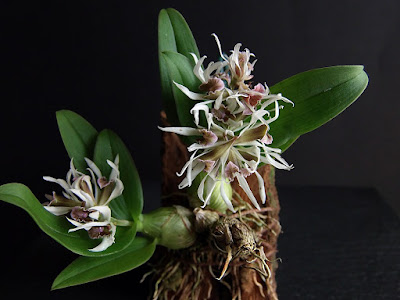Dendrobium peguanum is native to India and Myanmar. In India, they are widely distributed in the southwestern and southeastern hills in the state of Sikkim at an altitude of 300-400 m above sea level, and in Myanmar it grows along the border with India and along the eastern border with Thailand...
Dendrobium peguanum also called as The Pegu Dendrobium, Callista pygmaea, Dendrobium fesselianum, Dendrobium pygmaeum, Dendrobium wallichii, is a species of the genus Dendrobium. This species was described by John Lindley in 1859.
IDENTIFY DENDROBIUM PEGUANUM
Dendrobium peguanum is native to India and Myanmar. In India, they are widely distributed in the southwestern and southeastern hills in the state of Sikkim at an altitude of 300-400 m above sea level, and in Myanmar it grows along the border with India and along the eastern border with Thailand. These orchids are overgrown with rocks and thickets of bush near streams in a warm, humid, tropical zone.
It is a mini-miniature sized, hot growing lithophyte or epiphyte, which reaching a height of 12 cm, with stout, leathery, fleshy, tufted, ovoid to globose to oblong-conical, 3.6-6.0 cm long pseudobulbs carrying 2 to 4, sessile, broadly elliptic to linear-oblong, leathery, deciduous, acute to subacute apically, 3.5-7.5 cm long leaves.
The Pegu Dendrobium blooms in the late fall after a months dry spell on 1 to 3, short to 7.5 cm long, axillary, simultaneously one to 12 and more in cultivation flowered, racemose inflorescence that arise from the nodes at or near the apex of the newly leafless cane with fragrant flowers. The flowers are 1.2 cm in diameter. The white petals of whorls are sometimes purple. The dorsal petal is straight, the side petals have a sickle shape, the petals of the inner whorl are oval-lanceolate and have a slightly sickle shape. The 3-segment lip is beige or light brown with darker brown or purple stripes. The deeply waved central plot is colored amethyst or purple. It has a large, fleshy rod-like bulge between long side plots.
DENDROBIUM PEGUANUM CARE AND CULTURE
Cultural information should only be used as a guide, and should be to be adapted to suit you. Your physical location; where you grow your plants, how much time you have to devote to their care, and many other factors, will need to be taken into account. Only then can you decide on the cultural methods that best suit you and your plants.
Light:
Dendrobium peguanum needs a light level of 20000-30000 lux. These plants should be shaded during the brightest days, but they should be provided with the highest possible light level, so as not to burn the leaves.
Temperature:
The average temperature of the summer day is 30 ° C, the night 23-24 ° C, and the daily difference is 7 ° C. In spring, the average day temperature is 28-31 ° C, night 14-21 ° C, and the daily difference is 9-14 ° C. The average temperature of the winter day is 22-24 ° C, the night 9-11 ° C, and the daily difference is 13 ° C.
Humidity:
In summer, The Pegu Dendrobium needs the humidity of almost 85% and falls to 55-60% at the end of winter and at the beginning of spring.
Substrate, growing media and repotting:
These plants can be grown on tree rootstocks or cork, high humidity is ensured and watering is done at least once a day in summer. It may be necessary to irrigate them several times if the weather is very warm and sunny. If they are grown in pots, it is necessary to provide any loose, quickly drying substrate. Usually, a mixture of medium granular bark, cork or tree ferns is used. Repotting is best done at the beginning of spring, when new roots begin to grow.
Watering:
Dendrobium peguanum should be constantly moist from spring to early autumn, but when the new growth reaches maturity at the end of autumn, the amount of water should be gradually reduced.
Fertilizer:
It is recommended to apply a 1/4-1/2 dose of orchid fertilizer weekly. From spring to mid-summer you should used fertilizer enriched with nitrogen, and then until the end of autumn fertilizer enriched with phosphorus.
Rest period:
Cool, dry rest at an increased level of light may be necessary to initiate flowering. In winter, Dendrobium peguanum must dry out between waterings, but they can not stay dry for too long. Occasional morning fogging, especially in sunny, warm weather, will protect the plants from too much drying. Fertilization should be eliminated until watering increases in spring.















COMMENTS